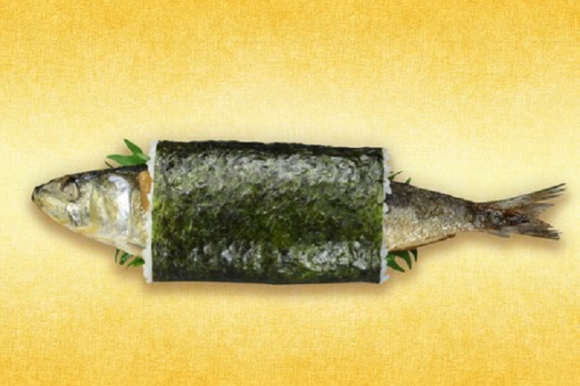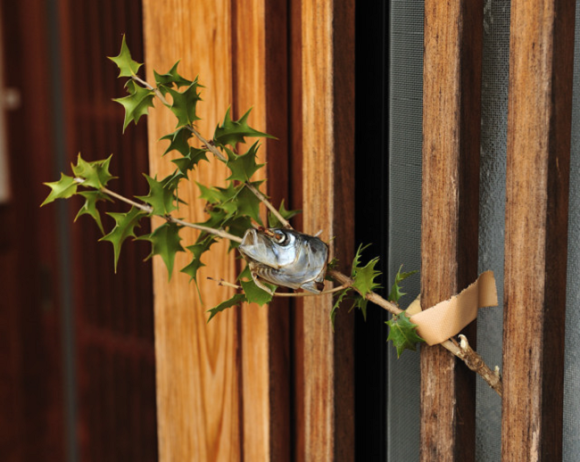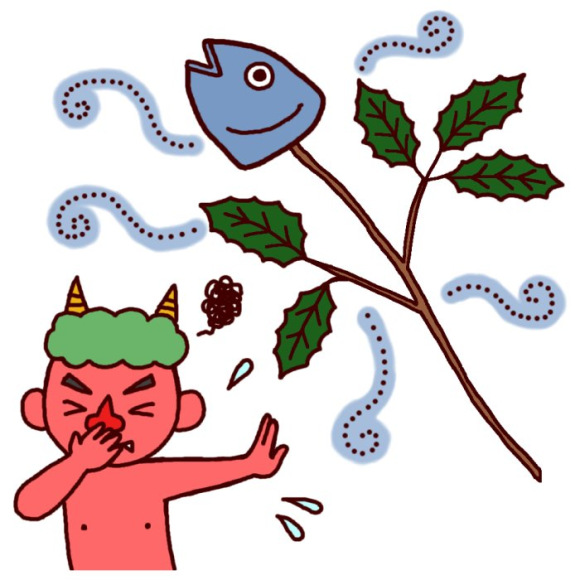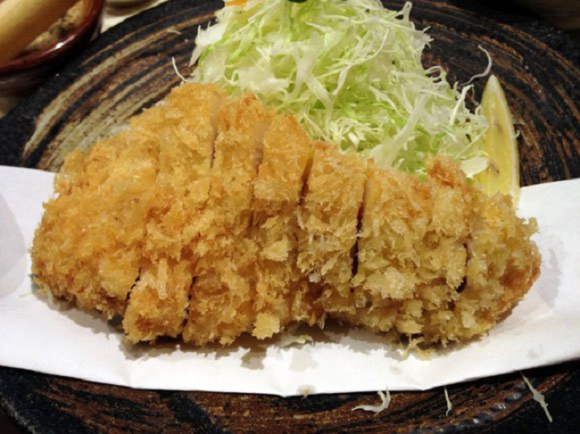
Even if you don’t speak Japanese, if you’re a sushi lover, you’ve probably heard some of the language’s fish-based vocabulary. Maguro is pretty readily understood as “tuna” among foodies with a palate for Japanese cuisine, and many people who can’t put together a complete sentence in Japanese still know that uni is sea urchin, for example.
Not as many non-Japanese speaking diners are as familiar with the word iwashi, or sardine, though. Although sardine sushi isn’t unheard of, it definitely trails in popularity behind less fishy-tasting fare, and its relatively low price and humble image mean it doesn’t have the same level of pizazz as a seaweed-wrapped pile of ikura (salmon roe) or a glistening cut of otoro (extra fatty tuna belly).
Visual impact isn’t a problem, though, for one Japanese restaurant chain’s latest creation: the Whole Sardine Sushi Roll.
We’re about a month away from Setsubun, which is celebrated on February 3. Originally meant to mark the start of spring in Japan, the holiday is sometimes referred to in English as the “Bean-Throwing Festival,” due to the practice of throwing roasted soybeans to ward off evil spirits. It’s also customary to eat one soybean for each year of your age to ensure good luck in the year to come.
Those aren’t the only traditions associated with Setsubun, though. Many people also buy ehomaki, thick sushi rolls, which they eat while facing towards whichever point of the compass has been deemed the most auspicious for the year. But perhaps the most unusual Setsubun activity is decorating the entrance to your home with something called hiiragi iwashi.
As you can see, that’s a cooked sardine head stuck on a sprig of holly. Like the roasted soybeans, hiiragi iwashi are thought to ward off demons and misfortune, as explained in this handy illustration.
▼ We imagine it has a similar effect on salesmen, religious solicitors, and actually just about anyone who gets within a few steps of your front door.
Kurazushi, one of Japan’s most popular budget-priced revolving sushi restaurant chains, has decided to combine ehomaki and hiiragi iwashi with its newest menu item, the 350-yen (US$2.90) Whole Sardine Roll.
Unlike an actual hiiragi iwashi, though, the 10-centimeter (3.9-inch) Whole Sardine Roll isn’t a strictly decorative piece. Featuring a whole Hokkaido-caught sardine, a leaf of oba (Japanese basil), and grated plum, it’s meant to be eaten, even if we’re not sure which end we’re supposed to start from. Kurazushi is even considerate enough to remove the backbone before serving it, although diners are still cautioned to be careful of smaller bones, which are always something to look out for when eating fish in Japan.
If you’re not up to the challenge of chowing down on a whole fish from head to tail (with the eyes included, of course), Kurazushi is also offering less extreme ehomaki, such as pork cutlet, shrimp, and egg.
We’re not sure if any of those offer the same two-for-one Setsubun effects of the Whole Sardine Roll, though, even if you decorate your house with one.
▼ Really, if you hang this on your doorknob, you’re just asking for a hungry RocketNews24 writer to come by and eat it.
Related: Kurazushi location finder
Source: IT Media
Top image: Kyodo News
Insert images: Exblog, Makotti, Kurazushi (1, 2), RocketNews24






 The greatest sushi roll in Japanese history is actually nine sushi rolls in one【Photos】
The greatest sushi roll in Japanese history is actually nine sushi rolls in one【Photos】 Pray for sound health for your beloved pets this Setsubun with special good luck sushi rolls just for them
Pray for sound health for your beloved pets this Setsubun with special good luck sushi rolls just for them Start saving room now – Japanese grocery store’s biggest sushi roll yet is coming for Setsubun
Start saving room now – Japanese grocery store’s biggest sushi roll yet is coming for Setsubun Japan’s crazy 6,000-calorie sushi roll includes a pizza as a topping
Japan’s crazy 6,000-calorie sushi roll includes a pizza as a topping American ehomaki? Searching for lucky Setsubun sushi rolls in the U.S.【Taste test】
American ehomaki? Searching for lucky Setsubun sushi rolls in the U.S.【Taste test】 Japanese expat remembers the words that changed his life when he started working in Australia
Japanese expat remembers the words that changed his life when he started working in Australia Nearly one in ten young adults living in Japan isn’t ethnically Japanese, statistics show
Nearly one in ten young adults living in Japan isn’t ethnically Japanese, statistics show Dragon Quest Burgers and Slime drinks are coming to McDonald’s Japan【Video】
Dragon Quest Burgers and Slime drinks are coming to McDonald’s Japan【Video】 Private booths are coming to Japan’s Shinkansen bullet trains even sooner than we’d thought【Video】
Private booths are coming to Japan’s Shinkansen bullet trains even sooner than we’d thought【Video】 Rakuten randomly offers 58 New Year’s osechi feasts in Japan, but did we get a star or a dud?
Rakuten randomly offers 58 New Year’s osechi feasts in Japan, but did we get a star or a dud? Top Japanese cosplayer Enako returns to Comiket after 6 years, creates mayhem with admirers
Top Japanese cosplayer Enako returns to Comiket after 6 years, creates mayhem with admirers Majority of Japanese mayors say foreign residents are essential but most see good and bad effects
Majority of Japanese mayors say foreign residents are essential but most see good and bad effects The 10 best day trips from downtown Tokyo【Survey】
The 10 best day trips from downtown Tokyo【Survey】 Japan’s Self-Defense Forces take “radio calisthenics” to an interesting new level
Japan’s Self-Defense Forces take “radio calisthenics” to an interesting new level Cosplay costume room tour by Japan’s number-one cosplayer Enako is an eye-opener【Video】
Cosplay costume room tour by Japan’s number-one cosplayer Enako is an eye-opener【Video】 Starbucks Japan ready to get Year of the Horse started with adorable drinkware and plushies【Pics】
Starbucks Japan ready to get Year of the Horse started with adorable drinkware and plushies【Pics】 Japanese beef bowl chain Sukiya’s 2026 Smile Box lucky bag basically pays for itself
Japanese beef bowl chain Sukiya’s 2026 Smile Box lucky bag basically pays for itself Hayao Miyazaki says Happy New Year to Studio Ghibli fans with new art for Year of the Horse
Hayao Miyazaki says Happy New Year to Studio Ghibli fans with new art for Year of the Horse Cup Noodle tries an authentic Jiro-style ramen, but something’s not quite right
Cup Noodle tries an authentic Jiro-style ramen, but something’s not quite right The best Starbucks Japan Frappuccinos we want to drink again in 2026
The best Starbucks Japan Frappuccinos we want to drink again in 2026 We revisited Sweets Paradise after a decade to see if Japan’s dessert buffet still delivers
We revisited Sweets Paradise after a decade to see if Japan’s dessert buffet still delivers That time Seiji called JASRAC to ask why he didn’t get paid royalties for his song being on TV
That time Seiji called JASRAC to ask why he didn’t get paid royalties for his song being on TV We found possibly the quietest Japanese-style hotel in Tokyo’s bustling Shinjuku district
We found possibly the quietest Japanese-style hotel in Tokyo’s bustling Shinjuku district Pizza Hut Japan’s hot lucky bags are perfect for a New Year’s pizza party
Pizza Hut Japan’s hot lucky bags are perfect for a New Year’s pizza party Japan’s oldest largetooth sawfish in captivity back on display in Mie Prefecture
Japan’s oldest largetooth sawfish in captivity back on display in Mie Prefecture 7-Eleven Japan starts new temporary luggage storage service in over 300 branches
7-Eleven Japan starts new temporary luggage storage service in over 300 branches Disillusionment at Tsukiji’s tourist-target prices led us to a great ramen restaurant in Tokyo
Disillusionment at Tsukiji’s tourist-target prices led us to a great ramen restaurant in Tokyo Starbucks teams up with 166-year-old Kyoto doll maker for Year of the Horse decorations【Photos】
Starbucks teams up with 166-year-old Kyoto doll maker for Year of the Horse decorations【Photos】 Tokyo considering law requiring more trash cans following litter increase in heavily touristed area
Tokyo considering law requiring more trash cans following litter increase in heavily touristed area Tokyo’s Tsukiji sushi neighborhood asks tour groups to stay away for the rest of the month
Tokyo’s Tsukiji sushi neighborhood asks tour groups to stay away for the rest of the month Tokyo event lets you travel back in time, for free, to celebrate 100 years since Showa era start
Tokyo event lets you travel back in time, for free, to celebrate 100 years since Showa era start Japan may add Japanese language proficiency, lifestyle classes to permanent foreign resident requirements
Japan may add Japanese language proficiency, lifestyle classes to permanent foreign resident requirements Sanrio theme park in Japan announces plans to expand into a Sanrio resort
Sanrio theme park in Japan announces plans to expand into a Sanrio resort Stamina-destroying “Paralysis Noodles” are Tokyo’s newest over-the-top ramen innovation
Stamina-destroying “Paralysis Noodles” are Tokyo’s newest over-the-top ramen innovation Survey asks foreign tourists what bothered them in Japan, more than half gave same answer
Survey asks foreign tourists what bothered them in Japan, more than half gave same answer Japan’s human washing machines will go on sale to general public, demos to be held in Tokyo
Japan’s human washing machines will go on sale to general public, demos to be held in Tokyo Japan’s deadliest food claims more victims, but why do people keep eating it for New Year’s?
Japan’s deadliest food claims more victims, but why do people keep eating it for New Year’s? We deeply regret going into this tunnel on our walk in the mountains of Japan
We deeply regret going into this tunnel on our walk in the mountains of Japan Studio Ghibli releases Kodama forest spirits from Princess Mononoke to light up your home
Studio Ghibli releases Kodama forest spirits from Princess Mononoke to light up your home Major Japanese hotel chain says reservations via overseas booking sites may not be valid
Major Japanese hotel chain says reservations via overseas booking sites may not be valid Put sesame oil in your coffee? Japanese maker says it’s the best way to start your day【Taste test】
Put sesame oil in your coffee? Japanese maker says it’s the best way to start your day【Taste test】 No more using real katana for tourism activities, Japan’s National Police Agency says
No more using real katana for tourism activities, Japan’s National Police Agency says Starbucks Japan reveals new sakura drinkware collection, inspired by evening cherry blossoms
Starbucks Japan reveals new sakura drinkware collection, inspired by evening cherry blossoms Updated cherry blossom forecast shows extra-long sakura season for Japan this year
Updated cherry blossom forecast shows extra-long sakura season for Japan this year We summon the Devil’s “sushi roll” in Tokyo because we need to eat this 6,000-calorie thing
We summon the Devil’s “sushi roll” in Tokyo because we need to eat this 6,000-calorie thing Celebrate the coming of spring by feasting on an enormous, $200 luxury Ehomaki roll!
Celebrate the coming of spring by feasting on an enormous, $200 luxury Ehomaki roll! These convenience stores really, really want you to buy their ehomaki Setsubun rolls
These convenience stores really, really want you to buy their ehomaki Setsubun rolls Tokyo to be treated with too many tantalizing ehomaki sushi rolls this Setsubun
Tokyo to be treated with too many tantalizing ehomaki sushi rolls this Setsubun Which Japanese conveyor belt sushi chain has the best iwashi sardine sushi?【Taste test】
Which Japanese conveyor belt sushi chain has the best iwashi sardine sushi?【Taste test】 Everyone in the office works together to make a “Dark Ehomaki Sushi Roll” for Setsubun
Everyone in the office works together to make a “Dark Ehomaki Sushi Roll” for Setsubun Which Japanese convenience store has the best lucky sushi roll? Unclear results show clear winner
Which Japanese convenience store has the best lucky sushi roll? Unclear results show clear winner Sushiro celebrates a traditional Japanese holiday with this…sushi thing
Sushiro celebrates a traditional Japanese holiday with this…sushi thing Can you make a proper ehomaki lucky sushi roll with Daiso equipment?
Can you make a proper ehomaki lucky sushi roll with Daiso equipment? Dean & DeLuca now has fancy good luck sushi rolls to help Japan celebrate Setsubun【Photos】
Dean & DeLuca now has fancy good luck sushi rolls to help Japan celebrate Setsubun【Photos】 Wish your loved ones great success this year with a slab of breaded beef in a sushi roll
Wish your loved ones great success this year with a slab of breaded beef in a sushi roll Subway rivals a traditional Japanese sushi roll with its own traditional Japanese BLT
Subway rivals a traditional Japanese sushi roll with its own traditional Japanese BLT $89 “Phantasmal Sushi Roll” fancies up life with Matsusaka beef and truffle salt 【Taste Test】
$89 “Phantasmal Sushi Roll” fancies up life with Matsusaka beef and truffle salt 【Taste Test】 This restaurant’s US$0.45 sushi is an amazing way to expand your sushi horizons in Tokyo
This restaurant’s US$0.45 sushi is an amazing way to expand your sushi horizons in Tokyo Japanese restaurant chain selling not just folded pizzas, but LUCKY folded pizzas!
Japanese restaurant chain selling not just folded pizzas, but LUCKY folded pizzas!
Leave a Reply